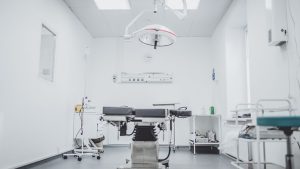
The ongoing Covid-19 pandemic has created a demand on the US healthcare system which has not been experienced in many years, creating an overwhelming need for Airborne Infection Isolation Rooms (AIIRs). Most hospitals have a limited quantity of AIIRs available and these are typically filled by the normal caseload of illness.
In the hardest-hit areas of the country, some hospitals must quickly create additional AIIRs to handle the significant influx of patients diagnosed with (or suspected to have) COVID-19. Higgins and Associates has been working with several of our hospital clients to quickly and effectively facilitate the conversion of applicable normal patient rooms to AIIRs using guidelines that have been established by the CDC.
The CDC recommends that:
- AIIRs are single-patient rooms at negative pressure relative to the surrounding areas, and with a minimum of 6 air changes per hour (12 air changes per hour are recommended for new construction or renovation).
- Air from these rooms should be exhausted directly to the outside or be filtered through a high-efficiency particulate air (HEPA) filter directly before re-circulation.
This CDC option allows the use of portable HEPA filtration unit(s) to increase the air changes per hour (ACH) within a normal patient room (which is about 6 air changes per hour) to more than 12 ACH. Portable room-air (HEPA) re-circulation units have been demonstrated to be effective in removing bioaerosols and aerosolized particles from room air.
The CDC has also updated these recommendations for engineering controls “to reduce or eliminate exposures by shielding HCP and other patients from infected individuals” by the use of “air-handling systems (with appropriate directionality, filtration, exchange rate, etc.) that are installed and properly maintained” and “direct all the air through HEPA filters before it is introduced to other air spaces.”
The CDC states that “portable HEPA filtration units should be designed to:
- Achieve ≥12 equivalent ACH
- Ensure adequate air mixing in all areas of the rooms
- Be compatible with the ventilation system
An estimate of the ability of the unit to circulate the air in a room can be made by visualizing airflow patterns (estimating room air mixing).”
The CDC also states that “Portable HEPA filter units previously placed in construction areas may be used in subsequent patient care, provided that all internal and external surfaces are cleaned and the filter’s performance is verified with appropriate particle testing and is changed, if needed.”
These options require the infection preventionist work closely with facilities engineering to ensure that all the engineering controls are properly designed and installed correctly.
Higgins staff have the knowledge of the CDC guidelines and infrastructures experience to work with your IP staff and facilities engineers to facilitate conversion of applicable patient rooms to AIIRs per CDC guidelines. Higgins can also provide particle testing of the HEPA filter exhausts to confirm that the filter’s performance is verified.
Please contact Art Goguen at agoguen@Higgins-and-Associates.com or call (303) 994-8122 to discuss these services in greater detail, or if you would like to request more detailed information on CDC guidelines.



